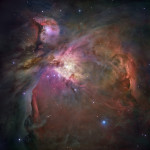by Erich Karkoschka
 Mercury is visible at dawn during the second half of the month
Mercury is visible at dawn during the second half of the month
to the left of Orion. On the 19th, it is to the upper right of
the extremely thin lunar crescent that is about as difficult to
see as Mercury. The following days Mercury becomes easier to spot.
 Venus is the morning star, with -4.7 magnitude at its brightest.
Venus is the morning star, with -4.7 magnitude at its brightest.
In early July it moves through the Hyades and then shines only
1 degree north of Aldebaran on the 11th. This is the closest
approach of a planet to Aldebaran during this century.
Venus is a nice crescent in a telescope and large binoculars,
especially early in the month. Venus is so bright that it can
be seen during daytime. The best opportunity to find it is on
the 17th when it is 4 degrees to the right of the thin lunar
crescent after sunrise.
 The moon celebrates our national holiday with a penumbral eclipse.
The moon celebrates our national holiday with a penumbral eclipse.
At 10:30pm, the upper left part of its disk is 1/3 less illuminated
than the rest of the disk. This is not noticeable since features
on the moon have larger contrasts. Despite the eclipse, this
Full Moon is brighter than most others.
Mars rises just before midnight and is 60 degrees high up at dawn.
It reaches -1 magnitude and 15 arc-sec diameter, rising toward
its good October opposition.
 Jupiter and Saturn come in Opposition in July and are visible
Jupiter and Saturn come in Opposition in July and are visible
all night. Their opposition dates (Jupiter on the 14th and
Saturn on the 20th) are only six days apart, which means that
they are only six degrees apart in the sky. Since their distance
is larger during all other oppositions between 1981 and 2059, it
may be called a once-in-a-lifetime event. Jupiter is magnitude
-2.8, almost its maximum possible, Saturn 0.1. In a telescope
 they show their largest disks, Jupiter 48 arc-sec and Saturn
they show their largest disks, Jupiter 48 arc-sec and Saturn
19 arc-sec, although its rings show up 42 arc-sec wide.
Saturn’s rings brighten significantly for several days around
opposition. This time they brighten up exceptionally because
the opposition is a perfect lineup as the Earth would be visible
transiting the disk of the sun as seen from Saturn, which happens
once every 15 years.
In the night of July 8 after 1am, Callisto and its shadow will
be visible on Jupiter’s disk, and the same happens for Ganymede
after midnight the following night. You can also catch the end
of a Callisto shadow transit on the 25th before 9:45pm.
Uranus and Neptune are up before dawn and will soon be back in
the evening sky.





